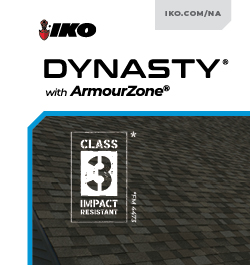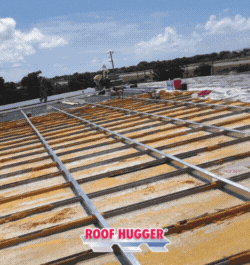Hip Problem
« Back To Roofers TalkI would appreciate some advice on a residential roof I am bidding. This roof has had chronic leaks since its installation. I have attached some pics of what I think is the problem... The hips are almost flat and I think water is getting under them. This is a 12 sided roof with this condition on each hip. I have some ideas, but wanted to see what you guys thought, as I mostly do commercial roofing. How can I install this detail to make sure we do not have problems own the road. New roof is going to be arch. shingles.Thank you.


Best thing to do 3/12 and under is install a rubber membrane low slope roof.
:woohoo: I get it; we're playing cops and roberts? :S
Check the slope to see if they are less than 4/12 and if they are ice and water shield the entire deck
Me too. I hate the stuff. I rarely ever use it for anything. And using a little of it under the caps may not be the best solution along with a re-roof but with a repair that only has to go a few more years until the roof is replaced, so far it has worked very well eliminating the problem every time.
All of the ones like this that I have done had rusted ridge nails. Some with the heads completely missing and water marks/debris showing that the water had ran to the nails.
Agree on the flatter shim. Willie, I'm painfully aware of what can happen when nail heads and shanks rust out. Actually that's why I made it a law never to use zinc chromate on anything. If there's a problem with wicking/syphon action I bring out the stainless. If it's just an iffy situation, I stick with hot-dip fasteners. But if the pitch is adequate, even if only nominally adequate, and you maintain the integrity of the roof planes to eliminate the cupping we can see in the photos, I don't see the need for any extra sealant. It should be a thing you don't walk away from until it is mechanically sound. "Water-shedding, not waterproof," as Mike Hicks once described it.
That having been said, if a particular geographic environment or location involving build-up of surface debris that retards drainage is in play, I have nothing against sealing the things down. Except for unusual situations that require repair of base flashings, stripping in, or such, I rarely use more than two three- gallon cans of mastic in a year, but I do use it and I do appreciate its value. After forty years of being up to my neck in the stuff and crawling inside my dryer with solvent and rags to satisfy an irate wife that every last speck of "that stuff" is off the drum, and after and despite religiously managing the tubes, guns, cans, and trowels, still having a small but malevolently genius spot of it work its way up the handle, onto my wrist, and propagate itself to the far corners of my universe with impunity, as much as I appreciate it, I find it annoying when I can't make something work without it. ;)
You can raise up the center of the ridge caps if you want but it's the water from the main roof running underneath the ridge caps and reaching the nail heads of the ridge caps that makes it leak.
It takes several years of the water reaching the nails for it to begin to rust them out and make its way around the stem of the nail. It only happens during the hardest rains and once water begins to infiltrate it will eat away at the roofing material around the nails as well making the hole around the nail stem larger. The leak grows very slowly.
When you tear this roof off, you will find that many of the nails used to install the ridge caps are rusted out.
That plan is just a little too very simple for me; I would need to feather both edges of that. I won't tolerate hidden voids or nonconformities beneath comp shingles. For one, ignorant people will inevitably step where they ought not, and secondly, comp will always stress over time wherever it is not fully supported. Nevertheless, whatever materials are employed, that would be the objective. I use tops or any other already generated waste material because it's totally compatible and its free.
1inch side up 2 inch side on horizontal flat to the ridge? 2 inch up might make a sever angle causing shingle failure at 90 B) :) :) B) Deep Down In Florida Where The Sun Shines Damn Near Every Day
egg Said: What tinner is talking about can pertain to a hip where the two adjacent sides that create it form a ninety degree turn. In this case, with the extremely obtuse angle, what is lacking is bulk in the center of the hip to help it retain what little angle there is. The same problem can occur on a ridge if you try to use that springy roll-type vent. The trim flattens out.If you handle it the way natty says it should be a non-problem. Occasionally when a hip trim flattens out like that and it is a low pitch, I will add a strip or two of narrow waste material, per twill. Whatever it takes to beef up the center and force it to take the shape its supposed to have.
Just my two cents.
Running an external caulking bead from a gun like someone did in the pix is just a little mini suicide.
Thanks for clarifying that for me. I sure leave a lot unsaid. Thank you.
What tinner is talking about can pertain to a hip where the two adjacent sides that create it form a ninety degree turn. In this case, with the extremely obtuse angle, what is lacking is bulk in the center of the hip to help it retain what little angle there is. The same problem can occur on a ridge if you try to use that springy roll-type vent. The trim flattens out.
If you handle it the way natty says it should be a non-problem. Occasionally when a hip trim flattens out like that and it is a low pitch, I will add a strip or two of narrow waste material, per twill. Whatever it takes to beef up the center and force it to take the shape it's supposed to have.
Just my two cents.
Running an external caulking bead from a gun like someone did in the pix is just a little mini suicide.
Yeah, that popping noise is annoying isn't it? :laugh:
Mike H Said: My hips are bothering me a lot here of late. Muscle cramps. Not that I expect that mean much here, but its about all I can offer on hips.:laugh: Mine seems to lock up sometimes, or slip out at times.:)
My hips are bothering me a lot here of late. Muscle cramps. Not that I expect that mean much here, but it's about all I can offer on hips.
:)
This is getting humorous!
The first place water gets to is the nails that were used to install the ridge caps. It would rarely, if ever reach the cuts on the hips.
It takes several years for the leaking to become evident.
Just a little strip of plastic cement placed outside where the nails are put into the ridge caps will stop the water from reaching the nails and the ridge from ever leaking.
This will work whether you like plastic cement or not. That has no bearing on the results.
Plastic cement does not fair well placed on top of shingles and left exposed to the elements, however it does very well when used to adhere one shingle to another by being placed underneath the top shingle and not left exposed.
Just be wary of the runny crap going around these days. The best bet would be wet/dry cement as it is thicker and cures faster.
DJ76 Said: Thanks guys for the responses.Rally appreciate the help. I would like to run the shingles straight over the hip as tinner666 suggested, but I was thinking once I bent the 6 section over the hip it may throw my alignment off. No??. If I do have to run caps I will probably strip hips with Grace I&W and also tar the underside of caps.
It doesn't throw the alignment off, but if it looks 'pointed' where they go over, trim a bit off the bottoms to align better with the course it's hitting.
Natty, I used to cut hips 'tightly', but learned it creates too much of a bend and can cause cracks. Hold off an inch, or two, and they lay over much more smoothly. :)























